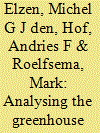|
|
|
Sort Order |
|
|
|
Items / Page
|
|
|
|
|
|
|
| Srl | Item |
| 1 |
ID:
121321


|
|
|
|
|
| Publication |
2013.
|
| Summary/Abstract |
As part of the Cancún Agreements, 45 non-Annex I countries have pledged mitigation action plans, of which 16 countries, including the seven major emitting countries, have submitted quantified mitigation actions. Many countries published their business-as-usual (BAU) emissions to which their pledges are connected. This study analyses the expected emission levels from the pledged, quantified actions, and whether these are consistent with achieving the 2 °C target. One of the main findings is that new BAU emission projections have led to about 2.5 GtCO2eq higher emission levels expected from pledges by non-Annex I countries. The emissions for non-Annex I countries as a group would be between 9% and 12% below our 2020 BAU emission projections, for, respectively, the unconditional and conditional pledges. This result might be conservative as we assume countries without quantified pledges follow BAU. This implies that for a medium chance of achieving 2 °C, Annex I countries would need to reduce its emissions by about 50% below 1990 levels by 2020. If Annex I countries as a whole would reduce emissions by 13% to 18% below 1990 levels, as expected from the pledges, the reduction of non-Annex I countries should be 22% to 34% below BAU levels for a medium chance of achieving 2 °C.
|
|
|
|
|
|
|
|
|
|
|
|
|
|
|
|
| 2 |
ID:
128441


|
|
|
|
|
| Publication |
2014.
|
| Summary/Abstract |
Many of the major greenhouse gas emitting countries have planned and/or implemented domestic mitigation policies, such as carbon taxes, feed-in tariffs, or standards. This study analyses whether the most effective national climate and energy policies are sufficient to stay on track for meeting the emission reduction proposals (pledges) that countries made for 2020. The analysis shows that domestic policies of India, China and Russia are projected to lead to lower emission levels than the pledged levels. Australia's and the EU's nationally legally binding policy framework is likely to deliver their unconditional pledges, but not the conditional ones. The situation is rather unclear for Japan, South Korea, Brazil and Indonesia. We project that policies of Canada and the USA will reduce 2020 emission levels, but additional policies are probably needed to deliver their pledges in full. The analysis also shows that countries are implementing policies or targets in various areas to a varying degree: all major countries have set renewable energy targets; many have recently implemented efficiency standards for cars, and new emission trading systems are emerging.
|
|
|
|
|
|
|
|
|
|
|
|
|
|
|
|
| 3 |
ID:
099252


|
|
|
|
|
| Publication |
2010.
|
| Summary/Abstract |
This paper analyses the environmental and financial consequences of various strategies of dealing with surplus emission allowances in the aftermath of the Copenhagen Accord. This topic remains relevant, in particular, with respect to the Russian negotiation position, as this country is the largest holder of surplus emissions. It is concluded that not addressing the surplus problem is not a feasible negotiation option, as the sheer size of the surpluses would jeopardise the environmental integrity of any future agreement. Cancelling surpluses against Russia's will, though viable, is not desirable, as it might well lead to this country opting out of this climate treaty. Three options for compromise have been selected and analysed here: (1) stricter targets for Annex I countries; (2) strategic reserve for Russia; (3) institutionalising optimal banking. It is concluded that, whereas option 1 is environmentally the best, in the present political context it is probably less feasible. The other two options, although environmentally suboptimal, seem politically more favourable. Our analysis suggests that maximal revenues for surplus-holding countries arise by releasing only a limited amount of surplus credits to the market. The institutionalisation of this effect could be a key lever to a politically feasible agreement on surplus emissions.
|
|
|
|
|
|
|
|
|
|
|
|
|
|
|
|
|
|
|
|
|